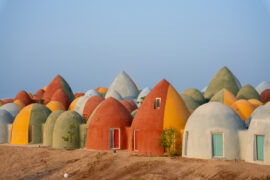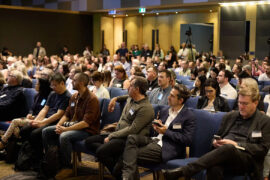k20 Architecture took a fresh, transparent approach to civic design for a local government site in Victoria’s west.
The Hindmarsh Shire Council Centre doesn’t really follow the typical design formula for civic buildings. Throughout Australia, most town halls and council chambers are threatening brutalist structures made of menacing heavy concrete. Others are lofty and formal Victorian-style halls with ornate gold chandeliers and plush carpet.
When conceiving a new design scheme for Hindmarsh Shire Council, k20 Architects felt the standard approach was dated, and worse—distanced and blocked off from the local community that the new building would inhabit, and hopefully enrich.
A conversation between the council CEO and k20 Architects’ director Theodore Kerlidis on the positioning of the front entryway became a decisive turning point in the design process. “They’d had a masterplan scheme created already, and [the CEO] turned to me and said, ‘I don’t even know where the front door on this scheme is’,” explains Kerlidis. “All of our discussions revolved around how the building was going to be culturally positioned; the purpose of the project and its community identity. This highlighted to me that the council project wasn’t really about just responding to a brief, or putting lines on paper. There was a need to create something culturally significant.”
Located in Nhill, somewhere between Melbourne and Adelaide, the completed site is a seriously sustainably focused precinct that’s purposefully reused the original 1960s building. “Part of the brief was to deliver within fixed budget parametres,” says Kerlidis. Unlike other local government projects, Hindmarsh’s new administration offices were not additionally funded by any State or Federal Government grant. “We really needed to think and provide a design solution that wasn’t programmatically driven but that allowed the end vision to be one that they could afford.”
The curved arch line of the building takes its cues from the shapes, spires and industry of local area. “There’s a lot of context in this area—though it can be the dullest of experiences,” says Kerlidis of the locale, which is known as a hub for wheat production. “You can really tune out, there’s flat land everywhere. The predominant image on the journey into the town is the smooth curved wall of wheat silos, as well as the pitched roof of the adjoining shed.” Kerlidis chose this local rural vernacular as his design inspiration for the shire offices. “There’s something really powerful and stable with that image,” he adds.
ESD principals were at the very heart of the building’s design intent. The design uses locally sourced materials, including folded sheet metal in steel and zinc manufactured for wheat silos, and a glulam Victorian ash timber primary structure to minimise the use of steelwork. Although double the size of the building it replaces, the centre uses 60 per cent less energy through a series of advanced and ingenuous innovations.
Transparency and accountability were also key for the new building. As well as the main building’s impressive glass façade, there are many open entryways (or front doors) and interconnecting pathways to create a relaxed and welcoming atmosphere. “A lot of council facilities are set up as corporate spaces, there is a lot of borrowed design methodology such as open plan work spaces or communal reading rooms. However, these tend to operate in isolation to what is actually in the public domain,” Kerlidis says. “The permeability of this building is as important as its discreet functionality.”
INDESIGN is on instagram
Follow @indesignlive
A searchable and comprehensive guide for specifying leading products and their suppliers
Keep up to date with the latest and greatest from our industry BFF's!

London-based design duo Raw Edges have joined forces with Established & Sons and Tongue & Groove to introduce Wall to Wall – a hand-stained, “living collection” that transforms parquet flooring into a canvas of colour, pattern, and possibility.

A longstanding partnership turns a historic city into a hub for emerging talent

In one of its biggest projects to date, ARM Architecture has completed the Sydney Opera House Concert Hall renewal. And it looks and sounds extraordinary.

Pingelly Recreation and Cultural Centre by iredale pedersen hook exemplifies design that is sensitive to place, people and culture:
a template for best practice into the future. We present to you, the winner of INDE.Awards’ Building category.

Respective of the site’s history and the role it has played in the state of Victoria, Winter Architecture and Zunica have transformed an existing cricket pavilion at the Kinley Cricket Club into one that fosters community engagement and activation.
The internet never sleeps! Here's the stuff you might have missed

Curated by the Indesign editorial team and hosted at leading showrooms, the Design Discussions series provided thoughtful reflection and debate on key issues shaping the industry.

The independent Master Jury of the 16th Award Cycle (2023-2025) has selected seven winning projects from China to Palestine.

Tickets for Architecture & Design’s 2025 Sustainability Summit are on sale. This 19 November, engage in ten expert-led panels on urban planning, AI, and circular economy. Join industry leaders in Sydney or online, and gain CPD-accredited insights to drive innovative, sustainable building solutions shaping our shared future. Plus on demand access to recordings.